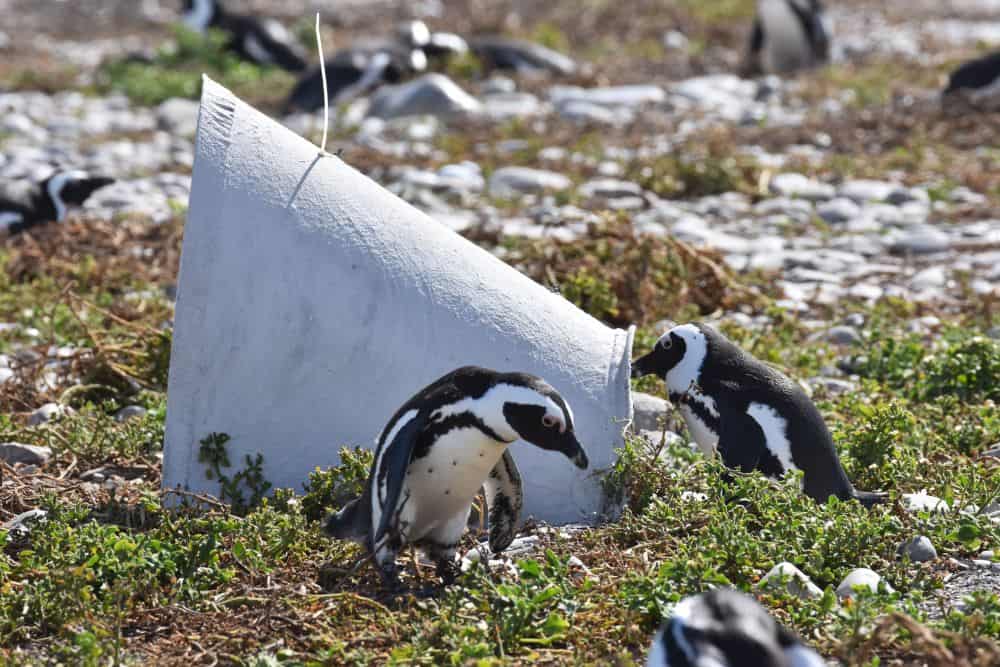
[Image above] African penguins check out the new double-layered ceramic nesting box. Credit: The African Penguin Nest Project
With the world on a “crash course” to reach 2.5°C of global warming, numerous members emphasized the need to prioritize tackling climate change during the 2022 United Nations Climate Change Conference (COP27) this November.
Unfortunately, to date, few countries are upholding their climate pledges. Instead, people living in areas that contributed less to climate change are disproportionality shouldering the burden of dealing with the more severe effects, such as those living in the Pacific Island region. (During COP27, negotiators agreed to establish a fund to pay for climate damages in poor nations.)
In response, many small companies and nonprofits are implementing climate resiliency efforts themselves. Traditional and advanced ceramics have a role to play in these efforts.
For example, different groups are exploring the use of local clay soil or chemically bonded ceramics to build homes rather than conventional concrete blocks. Clay is also being used to fabricate new “homes” (artificial reefs) for coral restoration.
In South Africa, the African Penguin Nest Project is also relying on ceramics to provide homes for the endangered African penguin.
The African penguin, also known as Cape penguin or South African penguin, is a species of penguin confined to southern African waters. They are the only species of penguin found in Africa.
Their numbers have plummeted over the past two centuries—from more than 4 million in the 1800s to less than 50,000 today—due to the destruction of nesting sites, egg poaching, oil spills, climate change, and competition for food resources with commercial fishing.
Regarding the destruction of nesting sites, the African penguin traditionally burrowed into the deep layers of guano that had built up over centuries of habitation. However, in the 1800s, a profitable trade opened for guano as fertilizer, and almost all the guano was removed from the African penguins’ breeding grounds. Without guano, the African penguins were left to nest in the open under the hot sun—which has only gotten hotter in recent decades.
Since 2009, artificial housing units (“nest boxes”) have been installed at various African penguin breeding sites to provide shelter from predators and the sun. However, initial nesting boxes yielded variable success. Concrete and fiberglass nesting boxes provided protection from predators but trapped heat, causing prolonged dangerously high daily nest temperatures. Penguins learned to avoid these nests due to lack of breeding success.
In March 2016, members of numerous conservation organizations, governmental offices, zoological facilities, and field researchers came together to develop, test, and install a new and more effective nesting box for African penguins.
After much study, the researchers decided on a new nesting box design that is similarly shaped to the natural burrows. The double-layered boxes are hand manufactured by applying several layers of slurry-soaked geotextile over a mold. The slurry consists of a ceramic powder, water, and a waterproofing agent. Included in some nests are environmental sensors, which provide a live data feed of temperature, heat stress index, and humidity conditions inside the nests.
During initial data collection, monitoring usage of the new nesting boxes was complicated by the appearance of highly pathogenic avian influenza (HPAI strain H5N8) in several coastal areas of South Africa. This virus restricted access to the colonies and monitoring of the nests due to the risk of cross-contamination.
However, in 2021, the team successfully completed a study on Bird Island between February and March. (Bird Island and its surrounding areas in Algoa Bay host nearly half of the global population of African Penguins.) This study culminated in an open-access paper published in October 2022.
The paper states the double-layered ceramic nests outperformed all other tested nest types (exposed surface nests, cement pipe nests, fiberglass nests, and natural burrows) by remaining cooler throughout the day. Temperatures never exceeding 36.7°C, in contrast to all other nest types experiencing multiple episodes where temperatures exceeded 40°C.
Additionally, the double-layered ceramic nests maintained constant levels of high humidity. (Increased humidity is necessary to prevent the egg membranes from drying out.)
Learn more about the team behind the African Penguin Nest Project at this link. For those who want to support this project, you can either sponsor the creation of a nest or purchase a product from the project’s shop. The video below provides a look at the new nesting boxes—and some cute African penguins!

Credit: Saving Penguins, YouTube
Update 01/25/2023 – Clarifications added after feedback from African Penguin Nest Project researchers.
Author
Lisa McDonald
CTT Categories
- Environment


